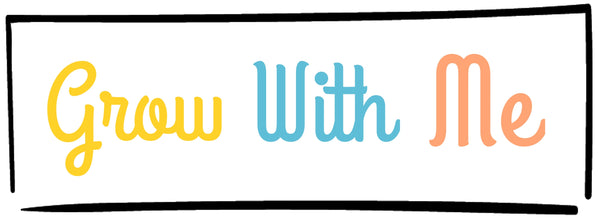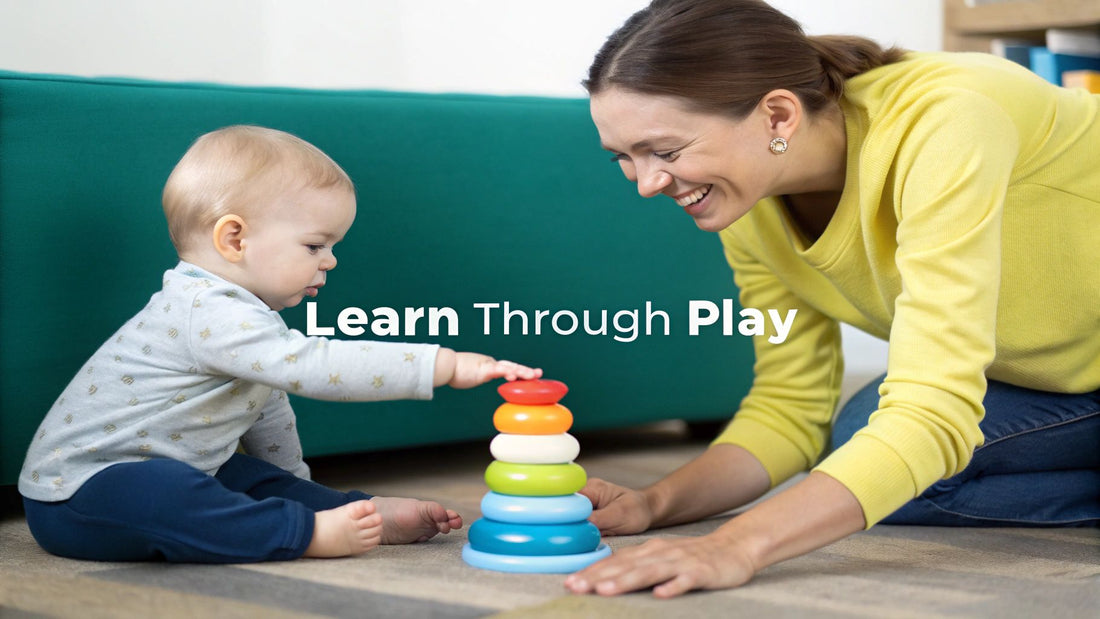
A Parent's Guide to Interactive Toys for Babies
Share
Interactive toys are a game-changer for little ones. They’re the playthings that react to what your baby does—lighting up, making a sound, or moving in response to a touch. It’s this back-and-forth that creates a brilliant little learning loop. Think of them less as a toy and more as your baby's very first conversation partner, sparking their curiosity every time they push, shake, or pat something.
The Magic of Play: What Are Interactive Toys?
Imagine the difference between a simple picture book and a pop-up book. One is lovely but static; the other brings a new world to life with every turn of the page. That’s the leap from a standard toy to an interactive one. At their heart, interactive toys are all about creating a 'conversation' between your child and their world.
When your baby bats at a hanging mobile and it chimes a gentle tune, or they press a button and a friendly face lights up, they're learning one of life's most powerful lessons: their actions make things happen. This is so much more than just a bit of fun; it’s the very beginning of understanding their own agency and control.
The Spark of Cause and Effect
This simple cause-and-effect relationship is the bedrock of early cognitive development. It teaches babies that they have influence, which in turn builds confidence and makes them want to explore even more. It doesn't take long for them to connect the dots: my push created that sound; my shake triggered that light.
This infographic shows a baby completely absorbed in this exact kind of play, discovering how their touch gets a reaction.
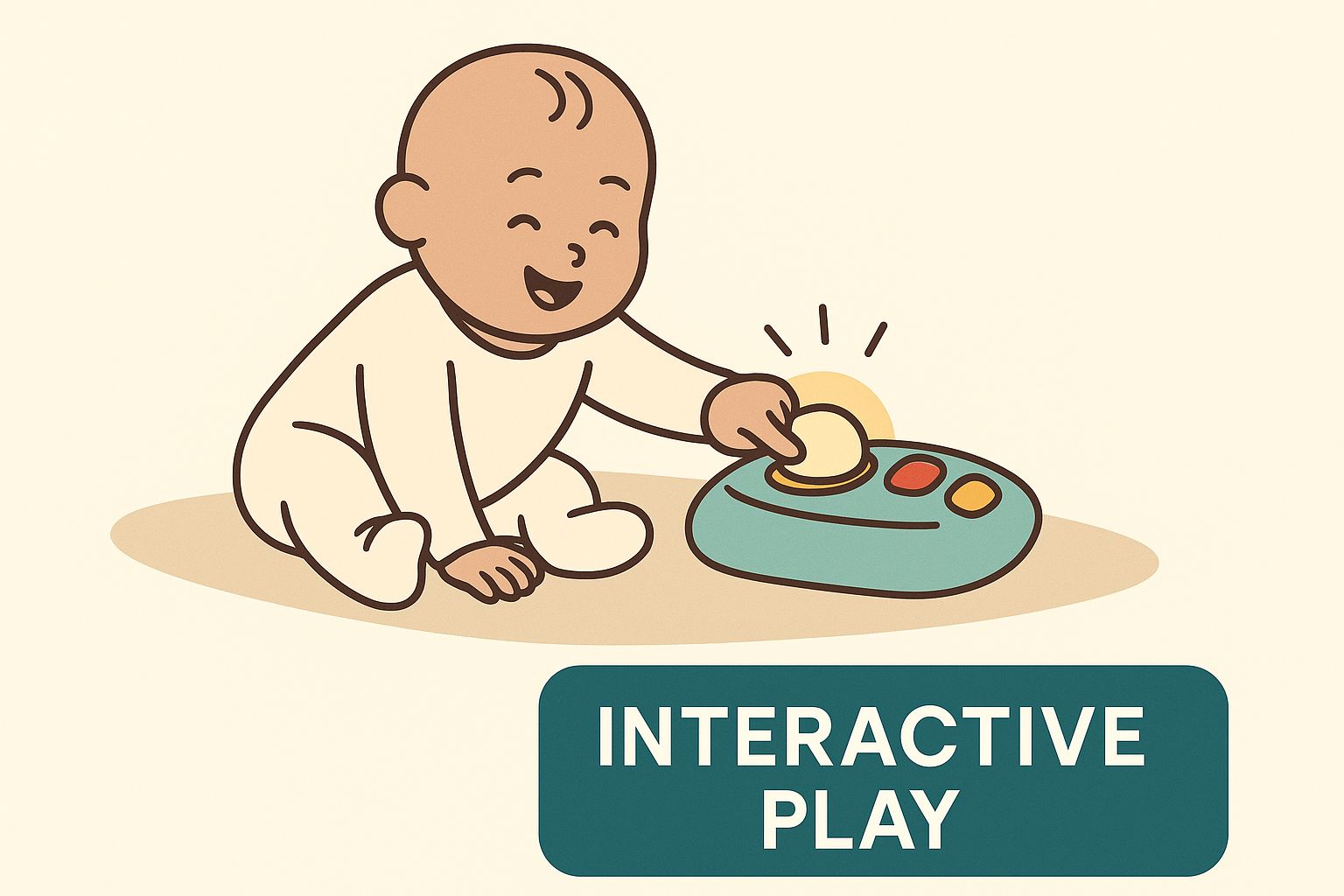
The picture captures that moment of discovery perfectly. A simple action like pressing a button ignites a whole sensory experience, forging new connections in their rapidly developing brain.
More Than Just a Distraction
It's easy to dismiss these toys as just a way to keep a baby occupied, but they are incredibly powerful developmental tools. The lights, sounds, and textures aren't random; they're designed to stimulate a baby's senses, which is a vital part of their early growth. They engage hearing, sight, and touch all at once.
An interactive toy isn't just an object; it's a responsive partner in your baby's journey of discovery. It invites curiosity and rewards exploration, laying the groundwork for a lifetime of learning.
This multi-sensory engagement is precisely why these toys are so effective. For parents who want to lean into this, exploring the world of sensory toys for babies is a great next step. In this guide, we'll dig into how this playful 'conversation' supports key milestones and helps you choose the right tools for your little one's incredible journey.
Of course. Here is the rewritten section with a more natural, human-written tone.
How Interactive Toys Boost Your Baby's Brain
You might see interactive toys as just bright, noisy gadgets designed to keep a baby occupied for a few minutes. But there’s so much more going on under the surface. They’re actually carefully designed tools for purposeful play, built to engage your baby's mind and body as they grow. Every single light, sound, and texture is a tiny invitation to explore, opening up a world of developmental opportunities.
When a baby gets their hands on one of these toys, they aren't just passing the time. They are actively forging the neural pathways that create the foundation for all future learning. Let's dig into exactly how these toys support your little one across four crucial areas of development.
Building Early Cognitive Skills
The very first big lesson an interactive toy teaches is cause and effect. Your baby pushes a button, and a song starts to play. In that moment, they learn a simple but powerful idea: "I made that happen!" This is the first spark of logical thinking and problem-solving.
This simple feedback loop is what drives them to experiment. You can almost see the gears turning: "If I press it again, will it make the same noise? What about that other button?" This natural curiosity is the engine that powers their cognitive development. Playtime becomes a series of mini-scientific experiments, helping them figure out how their world works.
The simple act of pressing a button to hear a sound is one of your baby’s first lessons in agency. It teaches them that their actions have predictable results, which builds confidence and a desire to explore further.
This isn't just about buttons, either. Think of an activity cube with all its different levers, spinners, and doors. It presents a whole host of cause-and-effect puzzles, challenging your baby to remember what each action does and encouraging them to connect their movements to the toy's reaction.
Igniting Sensory Development
From the moment they're born, babies learn about the world through their senses. Interactive toys are basically a feast for their developing sensory systems, offering a rich variety of sights, sounds, and textures that help their brains learn to process information.
A single toy often cleverly combines several sensory experiences to create a multi-layered learning opportunity. Just look at how these features work in tandem:
- Sight: High-contrast patterns and soft, flashing lights are brilliant for capturing a young baby's attention, helping them practise focusing and tracking objects with their eyes.
- Sound: A mix of gentle rattles, satisfying crinkles, and simple melodies helps them refine their hearing and learn to tell the difference between sounds.
- Touch: A whole range of textures—from soft fabrics and smooth plastic to bumpy rubber—encourages tactile exploration. This helps their brain build a 'map' of different physical sensations.
This sensory input isn't just for fun; it's absolutely vital for building a strong sensory processing system. It helps your baby make sense of their environment, learn to filter out what isn't important, and focus their attention—skills they'll rely on for the rest of their lives.
Developing Fine and Gross Motor Skills
Gaining physical coordination is a journey of a thousand tiny movements, and interactive toys provide the perfect motivation for all that practice. They encourage both the big muscle movements of gross motor skills and the delicate, precise actions of fine motor skills.
Picture a toy that rolls across the floor and plays music as it moves. That simple feature might be just the incentive a baby needs to start crawling, pushing themselves forward to chase after the sound. This builds strength in their arms, legs, and core, all while they think they're just having fun.
At the same time, these toys are fantastic for refining smaller, more fiddly movements. Choosing the right toy features can help your baby hit key physical milestones.
Matching Milestones with Toy Features
This table gives you a quick guide on how different toy features support specific developmental stages, helping you pick something that’s just right for your baby’s current abilities.
| Developmental Milestone | Interactive Toy Feature | Example of Play |
|---|---|---|
| Fine Motor Skills | Small buttons, dials, and switches | A baby uses their pincer grasp to press a specific button or turn a small dial on an activity board, strengthening hand-eye coordination. |
| Gross Motor Skills | Motion-activated music or lights | A baby is encouraged to roll over or crawl toward a wobbling toy that makes noise as it moves, building core strength and mobility. |
| Coordination | Kick-and-play piano mats | A baby lies on their back and learns to coordinate their leg movements to kick the keys and create sounds, linking action with an auditory reward. |
Every time your little one reaches out to bat at a hanging animal, grasps a textured ring, or pulls a lever, they are strengthening the small muscles in their hands and improving their dexterity.
Nurturing Social and Emotional Growth
While many interactive toys are brilliant for solo play, they can also provide some of the earliest lessons in social and emotional connection. Toys that have friendly faces, copy sounds, or play "peek-a-boo" are a gentle introduction to basic social cues.
For instance, a toy that giggles when it's shaken or says "hello" when a button is pressed introduces a simple, rewarding back-and-forth exchange. When you join in on the fun, narrating what's happening ("Look, the friendly lion is smiling!"), you add a rich layer of emotional context to the experience.
This kind of shared play helps your baby connect sounds and facial expressions with feelings, laying the groundwork for empathy and social skills down the line. They start to learn that sounds can be happy, actions can be surprising, and playing together is a joyful, rewarding thing.
Choosing the Right Toys for Every Stage
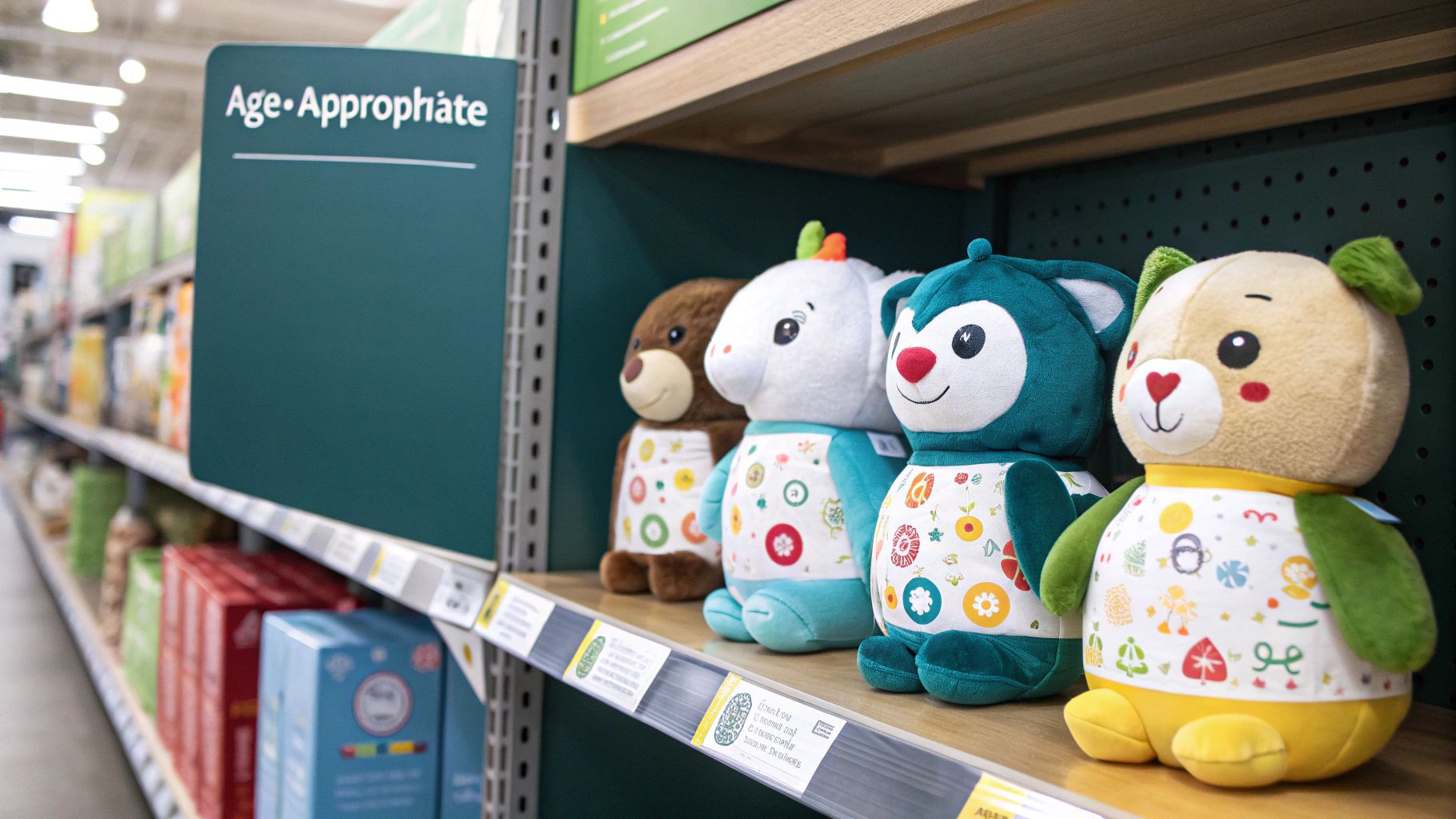
Picking out the perfect interactive toy isn't about grabbing the flashiest gadget off the shelf. It’s about matching its features to where your baby is on their unique developmental journey. You wouldn't offer a steak to a newborn, and in the same way, a complex puzzle will only lead to frustration for a three-month-old. The real magic happens when a toy meets your little one exactly where they are, giving them just the right nudge to take that next big leap.
To make things easier, we’ve broken down our recommendations by age. Think of this as your practical guide to the key skills your baby is mastering at each stage, along with the ideal interactive toys for babies that will support their incredible growth.
Newborns: From Birth to Three Months
In these first few months, your baby's world is a beautiful, blurry wonder. Their main job is simply learning to process all the new sights and sounds, and their vision is still a work in progress. What really grabs their attention are simple, high-contrast patterns and gentle sounds that intrigue them without being overwhelming.
At this point, their movements are mostly reflexive. They're just starting to figure out how to control their limbs, which makes toys that react to an accidental kick or a random bat of the hand absolutely perfect. The goal here is to gently stimulate their senses and introduce the amazing idea of cause and effect.
Look for toys with these features:
- High-Contrast Colours: Think bold black, white, and red. These are the easiest colours for a newborn’s developing eyes to see.
- Gentle Sounds: Soft rattles, chimes, or quiet melodies offer lovely auditory feedback without being too startling.
- Varied Textures: Simple materials like soft plush or crinkly fabrics give them a chance for tactile exploration.
A play gym with dangling high-contrast toys is a fantastic choice, as is a soft wrist rattle that jingles with their every little wiggle. These kinds of toys encourage them to reach out, kick, and discover their own power to make things happen.
Infants: From Four to Seven Months
This is an age of incredible discovery. Your baby is now becoming a little master of intentional movement. Those reflexive actions are turning into purposeful ones as they reach, grasp, and, of course, bring everything to their mouth for a closer inspection. Tummy time is paying off as they build core strength, and many are now rolling over or even sitting up.
Cognitively, the lights are really switching on. They now understand that their actions get specific results, and they'll happily repeat them over and over just to see the reaction. It’s the perfect time to introduce slightly more complex interactive toys.
Toys that motivate movement are key during this stage. A simple wobble toy that chimes when pushed can be just the encouragement a baby needs to reach out or attempt to roll over, turning playtime into a mini workout for their developing muscles.
Consider these toy characteristics for your growing infant:
- Easy-to-Grasp Objects: Look for toys with rings or handles that are ideal for little hands perfecting their grip.
- Motion-Activated Responses: A toy that lights up or plays a tune when it’s shaken provides brilliant motivation.
- Buttons and Switches: Big, simple buttons that reward their curiosity with sounds or lights are a huge hit.
Kick-and-play piano mats are also a brilliant choice for this age, helping to build leg strength and coordination. To explore this stage further, check out our complete guide on the best developmental toys for infants.
Older Babies: From Eight to Twelve Months Plus
Your baby is officially on the move! Whether they’re sitting confidently, crawling like a pro, or even pulling up to stand, their newfound mobility has opened up a whole new world. Their fine motor skills are also becoming much more refined, allowing them to use that clever pincer grasp to pick up small things and manipulate toys with real precision.
They are little problem-solvers now, ready for toys that challenge them to think, sort, and categorise. This stage is all about experimentation. They love multi-faceted toys like activity cubes, which have all sorts of doors, dials, and spinners to investigate.
The trend towards educational play is especially relevant here. In fact, consumer interest in toys that build early STEM skills is a major driver of the UK toys market, which was valued at around USD 3.91 billion and is expected to continue growing. You can learn more about this trend and find detailed market insights on expertmarketresearch.com.
Look for these more advanced features:
- Shape Sorters and Simple Puzzles: These are brilliant for building problem-solving skills and introducing concepts like object permanence.
- Levers, Dials, and Sliders: Playing with these helps refine hand-eye coordination and dexterity.
- Interactive Books: Board books with flaps to lift, textures to feel, and sounds to trigger are fantastic for early language skills.
By choosing interactive toys for babies that truly align with their developmental stage, you’re doing more than just providing entertainment—you’re giving them the perfect tools to build their brains and bodies, one joyful discovery at a time.
Your Essential Toy Safety Checklist
When you’re choosing interactive toys for babies, nothing matters more than safety. The bright colours, fun sounds, and engaging features are fantastic, but making sure every toy is completely safe is priority number one. This checklist isn’t about creating worry; it’s about giving you the confidence to build a secure and joyful play space for your little one.
Think of it like building a cot. You'd double-check every screw and slat to make sure it's a safe place for them to sleep. We should apply that same level of care to their toys. Knowing what to look for will give you total peace of mind, so you can focus on the fun.
Focus on Material Safety
Babies explore the world with their mouths, so what their toys are made of is incredibly important. The first thing to check is that the materials are non-toxic.
Keep an eye out for labels that clearly state a toy is:
- BPA-Free: Bisphenol A is an industrial chemical you'll want to avoid. Reputable brands make it a point to state their plastic toys are free from it.
- Phthalate-Free: Much like BPAs, phthalates are chemicals used to make plastics more durable. Look for toys that are explicitly phthalate-free.
- Non-Toxic Paints: If a toy is painted, the finish should always be water-based and non-toxic, making it perfectly safe for the inevitable mouthing.
Good manufacturers are proud of their safety standards and will have this information clearly displayed on the packaging. If you can't find these assurances, it’s probably best to pop that toy back on the shelf.
Inspect for Durable Construction
Next up, give the toy a good physical once-over. You'd be surprised how strong a baby's grip can be, and a flimsy toy can fall apart and create a real hazard. The biggest worry is small pieces breaking off and becoming a choking risk.
Give any attachments a gentle but firm pull – things like wheels, ears, or buttons. They should feel solid and securely attached. For soft toys, check the seams to make sure they're tightly stitched and won't easily tear, letting the stuffing out.
A well-made toy should be able to handle being dropped, chewed on, and pulled about without falling to bits. A quick 'stress test' before you hand it over is one of the simplest and most effective safety checks you can do.
This is especially important for any toy with moving parts. A quick inspection can spot a potential problem before it even becomes one, keeping playtime fun and worry-free.
Check for Secure Battery Compartments
Many interactive baby toys run on batteries, which brings us to another critical safety point. A loose battery is a serious danger if swallowed.
Because of this, you need to make sure the battery compartment is completely secure. The gold standard for toy safety is a cover that needs a tool to open it, usually a small screwdriver. This design makes it impossible for curious little hands to get inside. Never buy a toy with a battery cover that just clips or slides off.
Understanding UK Safety Markings
Here in the UK, we have specific safety marks that give us an extra layer of reassurance. When you're out shopping, there are two main symbols to look for on the toy or its packaging.
- CE Mark: This has been the long-standing mark showing that the manufacturer declares the toy meets EU standards for safety, health, and environmental protection.
- UKCA Mark: After Brexit, the UKCA (UK Conformity Assessed) mark was introduced. This is the new required marking for goods being sold in Great Britain and shows the product complies with all UK regulations.
Spotting either of these marks is a brilliant sign that the toy has been designed and tested with your child’s safety as a priority. It's your guarantee that it meets strict legal standards, giving you a baseline of quality you can trust.
Weaving Interactive Play into Your Daily Routine
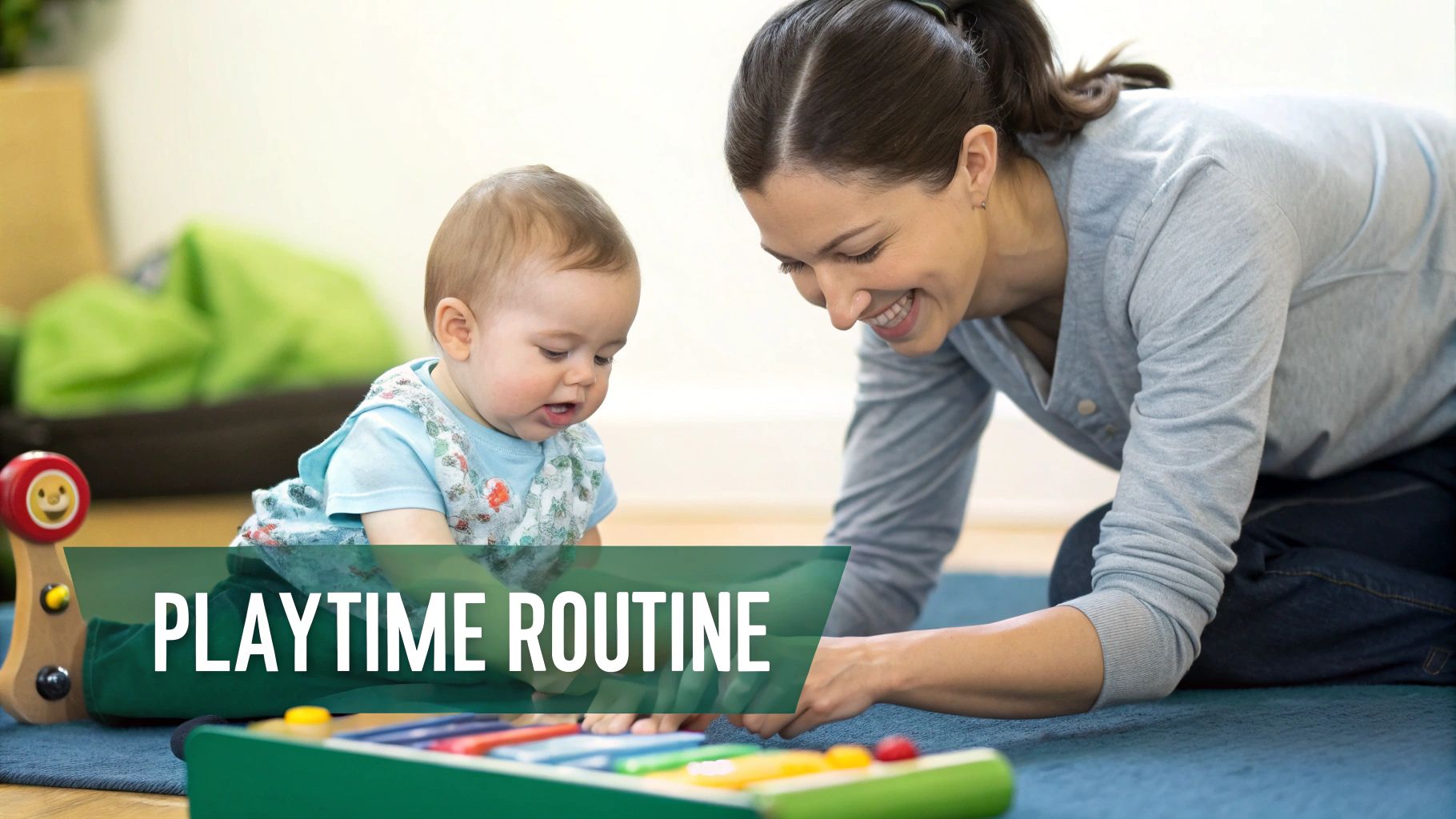
Having a stash of brilliant interactive toys for babies is one thing, but the real magic happens when you weave them into the natural rhythm of your day. This isn't about scheduling a rigid hour for "learning time." It’s about spotting opportunities in ordinary moments to connect and discover together.
Ultimately, you are the most important part of your baby’s play world. Your involvement is what turns a simple toy into a powerhouse for bonding and development. When you join in, you add a rich layer of context and emotion that a toy on its own just can't provide.
Making Everyday Moments Playful
You don’t need a complicated plan. It’s all about finding those little windows of opportunity and making play feel like a natural part of your routine.
Here are a few simple ideas to get you started:
- Tummy Time Motivation: We all know tummy time is crucial for building neck and core strength, but let's be honest, not every baby loves it. Try placing a musical wobble toy or a light-up roller just out of their reach. It can be just the thing to encourage them to lift their head and push up to see what’s going on.
- Changing Mat Distraction: Nappy changes can be a wriggly affair. Keep a small, easy-to-grasp interactive toy with interesting textures or sounds nearby. It can hold their attention just long enough to make the process a little smoother for everyone.
- High Chair Entertainment: While you’re getting a meal ready, a suction-cup spinning toy stuck to their high chair tray is a fantastic way to keep them happily engaged. They get to practise their fine motor skills, and you get a few precious moments.
- Winding Down for Bed: A quiet, interactive board book with soft sounds or gentle lights can become a wonderful part of your bedtime routine. It’s a lovely way to signal that it’s time to calm down and get ready for sleep.
By linking play to these daily activities, you’re not just making learning seamless; you're creating positive associations. Your baby starts to understand that play can be energetic and exciting, but it can also be calm and quiet.
Your Role as the Ultimate Co-Player
An interactive toy is great at teaching cause and effect, but you’re the one who teaches the joy and meaning behind it all. Your participation elevates the experience from a simple action-reaction loop to a rich, developmental interaction.
When you engage with your baby during playtime, you're not just showing them how a toy works. You're showing them how the world works—through connection, communication, and shared discovery.
This active participation is easier than it sounds. It’s simply about being present and responsive. It can be as simple as talking about what’s happening, asking questions, or just mirroring their excitement.
Simple Techniques to Amplify Learning
Ready to become a play expert? Here are three powerful techniques you can use to make playtime with interactive toys for babies even more meaningful.
- Narrate the Action: Think of yourself as your baby's personal storyteller. When they press a button, describe what happens in simple terms. "You pushed the red button, and listen! It made a happy song." This is brilliant for connecting their actions to language, building crucial vocabulary from day one.
- Ask Open Questions: Even before your baby can talk, asking simple questions helps their brain start making connections. Hold up a toy and ask, "What do you think this does?" or "Shall we see what sound the cow makes?" It models the natural back-and-forth of conversation and sparks their curiosity.
- Share in Their Excitement: Your emotional response is a huge motivator. When your baby manages to stack a ring, celebrate with them! A big smile, a gentle clap, and an encouraging "You did it!" provides the kind of positive reinforcement that builds their confidence and makes them eager to try again.
The UK baby toys market was valued at approximately USD 821.5 million and is expected to grow significantly, largely because more and more parents are seeking out these enriching play experiences. This growth means there are more options than ever for turning simple moments into powerful opportunities for discovery.
For more creative ways to engage your baby's senses, explore our guide on sensory play ideas for babies.
Answering Your Top Questions About Interactive Baby Toys
Even after diving into all the benefits and safety checks, it's completely normal to have a few questions buzzing around. As parents, we want to get it right. This section is all about tackling those common queries head-on, giving you clear, practical answers so you can feel totally confident about the toys you bring into your home.
Think of this as our final chat over a cup of tea, tying up any loose ends. We’ll cover everything from noise levels to how many toys are actually enough, making sure you have all the pieces of the puzzle.
Are Noisy Toys Bad for My Baby?
This is a big one, and I get asked it all the time. The short answer is no, not at all—as long as you strike the right balance. Toys with different sounds, gentle jingles, and simple tunes are fantastic for your baby's auditory development. They're learning to pick out and tell the difference between noises, which is a crucial skill.
The trouble starts when a toy is just too loud, or when it endlessly repeats the same jarring sound bite. That can easily overwhelm a baby's sensitive, developing brain. My best advice? Always, always look for a volume control switch. You'll find that a lower setting is usually more than enough to capture their interest without being overstimulating.
The real aim is to create a rich and varied soundscape for your baby, not a constant barrage of electronic noise. A healthy auditory diet is a mix of everything: a musical toy, some quiet time with a soft book, the sound of your voice reading a story, and you chatting with them.
At the end of the day, it's all about moderation. An interactive toy that plays a sweet song is a wonderful tool, but it should be just one part of a play routine that includes plenty of quiet, unplugged time too.
How Many Interactive Toys Does My Baby Actually Need?
When you’re building your baby’s toy collection, remember this: quality always wins over quantity. In fact, surrounding a baby with too many toys can backfire. It becomes overwhelming, making it hard for them to focus on any single item long enough to really explore it.
A small, carefully chosen selection of three to five high-quality interactive toys is more than enough to have out at any one time. This encourages them to go deeper with their play and truly master what each toy has to offer. One of the best-kept secrets among parents is toy rotation.
It's brilliantly simple:
- Pick a few: Choose a handful of age-appropriate toys to leave out for your baby.
- Stash the rest: Put the other toys away in a cupboard, completely out of sight.
- Swap them out: Every week or two, switch the toys on display with a few from the "hidden" collection.
This little trick makes old toys feel brand new again. It reignites that spark of curiosity and gets your baby to engage fully with each item, instead of just flitting from one thing to the next.
Can These Toys Replace Playtime with Me?
This is probably the most important question of all, and the answer is an absolute, unequivocal no. Interactive toys are brilliant tools, but they were only ever designed to be supplements to your interaction, never a substitute for it.
Nothing can replace you. Your baby learns the most fundamental lessons about language, emotion, and connection from your face, your voice, and your touch. No toy, no matter how clever, can replicate the warmth of a cuddle or the joy in your eyes. The real magic happens when you use these toys together.
Get down on the floor with them. Point to the flashing lights and talk about the colours. Show them how to press the button and celebrate with them when they do it themselves. Your involvement is what turns a simple toy into a shared adventure. It’s how you build your bond and multiply every single learning benefit that toy has to offer.
At Grow With Me, we believe that the right toys at the right time can make all the difference. Our stage-based play kits are designed to support your baby’s development every step of the way, making it easy to provide enriching, age-appropriate play experiences. Discover our curated subscription boxes and start your play adventure today at https://shop.growwithmesubscriptionbox.co.uk.
